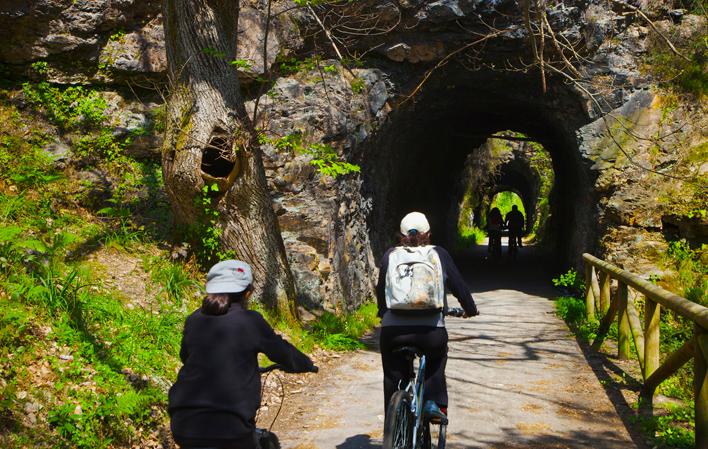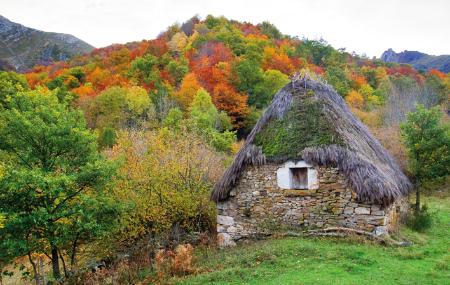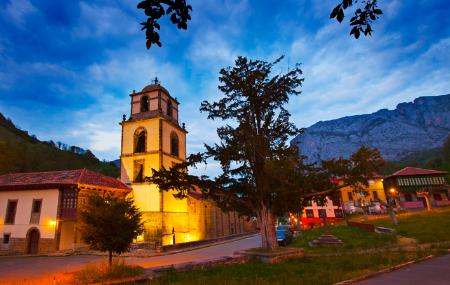
- Address Santo Adriano, Proaza, Teverga y Quirós, Yernes y Tameza, Somiedo Central Asturias
- Distance Distance: 53 kms
- Cars Cars: 5 days
- Start point Start point: Valles del Oso
- Route type Route type: coche
- Layout of the route Layout of the route: Download kml
In times of Emperor Augustus, the Romans entered Asturias over the high mountain ranges traversed by deep gorges.
In times of Emperor Augustus, the Romans entered Asturias over the high mountain ranges traversed by deep gorges The Camín Real de la Mesa was one of the most important road links from those ancient times up until the 19th century and today constitutes the backbone of the territory.
Santo Adriano - Proaza - Teverga - Quirós - Yernes y Tameza - Somiedo
Day 1: Tuñón - San Martín de Teverga 20,4
Day 1: The tour of the Camín starts off in the Bear Valleys, in the boroughs of Santo Adriano, Proaza, Teverga and Quirós. So the best option to get to know these lands is enter them via the hiking path of the same name: The Bear's Trail. Built on the cutting of a former railroad, it is flat, suitable for all comers and is dotted with recreational areas. It has two branches which can be explored on foot or by bicycle (available for rent). The original runs between Tuñón and Entrago and is just under 20 kilometres long. Another branch which commences near the end of the original trail heads towards Quirós adding almost 13 kilometres to the hike. The excursion can be completed with a visit to the Bear Enclosure, located on the trail, where two brown bears rescued from poachers live in semi-captivity.
Day 2: San Martín - Yernes y Tameza - Entrago - San Martín 49,5
Day 2: You will now climb your first summit. Just a half-hour drive from Sanmartín, Marabio Port rises above 1,000 m. in altitude and is formed by an extensive mountain meadowland. Near the Chapel of Santa Ana, there is an area to leave the car and take a walk or follow a 3-hour circular hiking route. Further on along the road to Marabio, you come to Villabre. Less than a hundred people now live in the borough capital of Yernes y Tameza reside, but the typical high-mountain buildings are conserved intact. Back in the Bear Valleys, there is still time to visit the Prehistory Park, in San Salvador de Alesga and discover the best examples of rock art. Within walking distance is Huerta Cave, a karst system with a depth of 14.5 kilometres, which can be visited the first 300 meters. It is essential to book in advance.
Day 3: Entrago - Pola de Somiedo 51,8
Day 3: From the Bear Valleys to Somiedo. The trip from Teverga to Pola de Somiedo takes about 50 minutes on the AS-265 mountain road and the AS-227. The Somiedo Nature Park Interpretation and Visitor Centre in La Pola is a first stop for gain a better understanding of this area. A walk through the village allows you to acclimatise to the setting. Somiedo Ecomuseum provides a more in-depth explanation on the combination of nature and culture. It is housed in two different buildings. The first, devoted to Crafts and Nomadic Herding, is in Caunedo, 3.5 kilometres south of the town on the AS-227. To get to the second, La Casa Veigas, you need to take the AS-227 in the opposite direction from La Pola and head towards Saliencia on the SD-1.
Day 4: Pola de Somiedo - Lagos de Saliencia - Belmonte de Miranda 65,8
Day 4: The mountain also have to be explored on foot and Somiedo offers a variety of different options. An interesting option for a day of leisure in the countryside are the Saliencia Lakes. The complete Saliencia route (including the Cueva, Calabazosa, Saliencia, Cerveriza and El Valle lakes) is 14.5 km long (each way), which can be covered in about four and a half hours. There is also a shorter 7-km version taking about two hours, which excludes El Valle Lake. The starting point for both is at Alto de la Farrapona, which must be accessed by a track that has been conditioned for traffic The second option - more suitable for lovers of ethnography and culture - is the La Pornacal Trail, which heads out of Villar de Vildas, a village which is accessed via a turning off the AS-227, in Aguasmestas. This braña or high mountain meadow preserves 32 teitos, thatched huts that served as a dwelling or as stables for livestock. The shortest route is 4.5 kilometres in length and can be prolonged to Braña Viecha.
Day 5: Belmonte de Miranda - Candamo 40,2
Day 5: The journey continues northward on the AS-227 to Belmonte de Miranda. This town is home to the Gold Educational Exhibition, installed in the old jail, a reminder to travellers that they are in a gold basin. The next stop is in the centre of Grado, a town with a protected historic-artistic site, which encompasses the Miranda-Valdecarzana Mansion, the remains of the town walls, chapels and Indiano villas built by returning emigrants who had made their fortune in the Americas. To complete the route followed by the Romans via the Camín Real de la Mesa, you need to travel next to San Román de Candamo from Grado on the AS-237 to visit La Peña Cave, a UNESCO-listed World Heritage Site, which houses cave paintings discovered in 1919. You need to check on opening dates and book well in advance.




